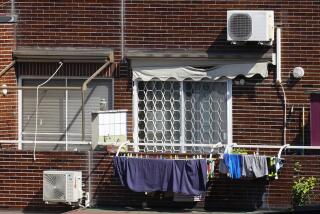10 surprising air-conditioning facts from the new book ‘Cool’

- Share via
The easiest way to beat the heat this weekend may be to turn on your air conditioning. But the road to being able to flip a switch to cool down your house was not so simple. As author Salvatore Basile explains in his new book “Cool: How Air Conditioning Changed Everything,” the path to easy, affordable ways to cool down took a path through ice, ammonia, fans, pipes, blowers, coils and more. Here are some surprising things you probably don’t know about air conditioning.
1. If you go to a movie to beat the heat this weekend, you’re not the first. In fact, major advances in air-conditioning technology began in 1917, when theater owners wanted to fill seats during sweltering summers. With no home air conditioning, people flocked to movie theaters, whose advertisements featured lettering dripping with icicles.
2. In 1736, the English House of Commons was cooled by a seven-foot, hand-cranked “blowing wheel.” The man at the crank was known as the Ventilator.
3. An ice-making machine was patented as early as 1851, but American ice interests, which had a network that stored and transported lake ice from cold regions, managed to quash it.
4. A variety of machine cooling systems were developed, but they were slow to catch on. In 1891, a St. Louis company transformed a beer hall and restaurant into an “Ice Palace.” Chilled by refrigeration, painted with murals of a polar expedition, it displayed frost-coated pipes spelling out the prorprietor’s name to passers-by. Those who left the 90-degree temperatures outside for the 70 degrees inside considered it merely a pleasant oddity.
5. An unnamed California millionaire was the first to try cooling an entire room in his home mechanically, in 1892. It was only 6 feet by 9 feet and required a false wall to conceal machinery, more of which was located on the roof. (Could it have been William Randolph Hearst? That’s my guess).
6. Two early successful ventilation systems were installed in 1899 in Cornell’s dissecting rooms (for the cadavers) and 1903, at the New York Stock Exchange (for the stockbrokers).
7. Willis Haviland Carrier, whose patents and ideas created the first widely popular factory-scale coolers, was so absorbed in creating his air conditioner that he once left for a business trip with a large suitcase in which he had packed nothing but a handkerchief.
8. The first fully air-conditioned residence was built in Minneapolis in 1913 by Charles “Spend-a-Million” Gates, heir to a barbed-wire fortune. The mansion, taking up three city lots, also boasted gold plumbing and a ballroom, but Gates never got to experience it: He died while on a hunting trip before the house was finished.
9. The first U.S. president to enjoy an air-conditioned Oval Office was Herbert Hoover, who spent $30,000 on the system just months after the stock market crash of 1929.
10. If you tried to buy an in-window air-conditioning unit in the 1940s, you’d spend about about $350 in 1940s money, which in today’s dollars is almost $3,500.
Book news and more; I’m @paperhaus on Twitter
More to Read
Sign up for our Book Club newsletter
Get the latest news, events and more from the Los Angeles Times Book Club, and help us get L.A. reading and talking.
You may occasionally receive promotional content from the Los Angeles Times.









